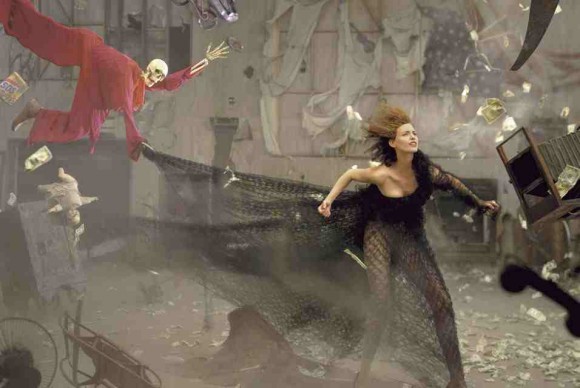Famed Fashion Photography of Richard Avedon on View at the Norton Museum of Art
February 7, 2010 by All Art News
Filed under Photography
WEST PALM BEACH, FL.- Avedon Fashion 1944-2000 will be on view at the Norton Museum of Art from February 9 through May 9, 2010. The first exhibition devoted exclusively to Richard Avedon’s fashion work, it will feature over 150 objects, including photographs from throughout his productive career, as well as original magazines showing his work in context and materials demonstrating his creative process.

Nadja Auermann and A Person Unknown, dress by Romeo Gigli, pajamas by Masha Calloway, Montauk, New York , August 1995
Richard Avedon is the most significant and influential photographer to have taken fashion as one of his subjects. He began working for Harper’s Bazaar in 1944, when he was only twenty-one, and revolutionized fashion photography, dispensing with its prevailing mannered and statically posed formulas and introducing a more youthful, spirited, and distinctly American style. Inspired by Hungarian photographer Martin Munkacsi and encouraged by legendary Harper’s Bazaar art director Alexey Brodovitch, he took models out of the studio and photographed them in motion to exhilarating effect. His collaborative efforts with Brodovitch allowed Avedon a great deal of freedom in composing his photographs, as well as a great degree of editorial control over Harper’s Bazaar’s use of his images. Working in Paris in the 1950s, he spun a cinematic narrative around the couture collections with his revolutionary outdoor images, evoking a vision of Paris at its most glamorous and intoxicating in what was still a grim postwar city. The extended narrative was one of his most imitated innovations. He was as inventive as he was prolific, constantly pushing the boundaries of what was acceptable in fashion photography, such as his inclusion of models who were Asian and African American, and his avant-garde pop culture references. His two decades at Harper’s Bazaar are remarkable for their inventiveness and originality, as well as their breathtakingly hectic pace.
By 1957, little more than a decade into his career, the unmistakable hyperkinetic sensitivity of his work had become well known, as had the growing myth of Avedon himself. He was the inspiration and visual consultant for Stanley Donen’s film Funny Face, with the Avedon role played by Fred Astaire, and his reluctant model played by Audrey Hepburn. Avedon was the epitome of the modern fashion photographer—charming, sophisticated, and suddenly as famous as his celebrity portrait subjects. More so than any other fashion photographer, Avedon reflected the mood of the moment through his work, from postwar optimism to Pop exuberance. He was sensitive and responsive to the new sense of power, determination, and freedom gained by women during the mid twentieth century.
His favorite models had character and a collaborative spirit, and he not only encouraged them to express it, but he made them famous for it. While at Harper’s Bazaar, he helped Suzy Parker achieve a level of renown rare for models, and after following former Harper’s Bazaar fashion editor Diana Vreeland to Vogue in 1966, he gave many more previously anonymous models prominent credits and fame through his images. A new cult of celebrity bloomed for Jean Shrimpton, Lauren Hutton, Twiggy, Penelope Tree, and Veruschka, ushering in the age of the supermodel and raising the profile of fashion photography within popular culture.
Avedon’s work at Vogue became more provocative in response to the sexual revolution of the late Sixties and Seventies, but his most memorable and exciting images from this period are of models in motion—sprinting across the page on a headlong rush into the future with the trademark “Avedon blur,” where the camera captured figures mid-motion. Although Avedon remained at Vogue until 1988, he did little editorial photography in his final years there, only picking it up again for extended sequences in Egoїste magazine and, later, features in The New Yorker as their first staff photographer, including “In Memory of the Late Mr. and Mrs. Comfort,” a sensational 1995 color portfolio set in post-apocalyptic ruins. Avedon’s last major narrative, this portfolio will be included in the exhibition in abbreviated form, along with key examples of his witty advertising work for Versace and Dior. Throughout his nearly seven decade career, Avedon’s images were infused with an undeniable sense of personal style and a unique take on the importance of fashion in our lives.
